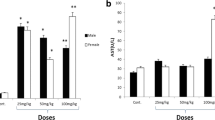Abstract
The relationship was investigated between biochemical and morphological changes in chloroform (CHCl3)- and carbon tetrachloride (CCl4)-induced liver damage. The time courses of hepatic microsomal cytochrome P450 (CYP) content, hepatic microsomal CYP2E1 activity, hepatic reduced glutathione (GSH) content, plasma alanine aminotransferase (ALT) and aspartate aminotransferase (AST) activities were examined in relation to the liver morphology in rats orally treated with CHCl3 or CCl4 (3.35 mmol/kg). The CYP content and the activity of CYP2E1 markedly decreased in the CCl4-treated rats 3 h after treatment compared to much lower decreases in the CHCl3-treated rats. The hepatic GSH content was decreased to a similar extent in both groups of rats at 3 h after treatment; in the CCl4-treated rats, the GSH content continued to decrease, reaching a minimum at 24 h and without attaining the normal level at 72 h after treatment. By contrast, hepatic GSH content in the CHCl3-treated rats began to increase from 6 h, attaining complete recovery 48 h after treatment. Plasma ALT and AST activities were significantly elevated by CCl4 as early as 3 h after treatment, while the activities in the CHCl3-treated rats did not increase until 6 h after treatment. In both groups of rats, ALT and AST activities reached a maximum at 24 h, and gradually decreased, remaining at abnormal levels at 72 h. Hepatic cells in the CCl4-treated rats were found to be necrotic as early as 3 h post-treatment, whereas few or no morphological changes appeared in the liver of CHCl3-treated rats. The extent of necrosis was at a maximum 24 h after treatment in both CHCl3- and CCl4-treated rats. In addition, some necrotic cells remained in the liver of CCl4-treated rats 72 h after treatment, while the necrosis in the CHCl3-treated rats was almost negligible. The present results indicate that almost the same time-courses of biochemical and morphological changes were followed in rats of both the CHCl3- and CCl4-treated groups.
Similar content being viewed by others
Author information
Authors and Affiliations
Additional information
Received: 11 February 1997 / Accepted: 12 May 1997
Rights and permissions
About this article
Cite this article
Wang, PY., Kaneko, T., Tsukada, H. et al. Time courses of hepatic injuries induced by chloroform and by carbon tetrachloride: comparison of biochemical and histopathological changes. Arch Toxicol 71, 638–645 (1997). https://doi.org/10.1007/s002040050438
Issue Date:
DOI: https://doi.org/10.1007/s002040050438




